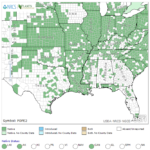Persicaria bicornis
USDA, NRCS. 2018. The PLANTS Database (http://plants.usda.gov, 28 March 2018). National Plant Data Team, Greensboro, NC 27401-4901 USA.
Illustration: USDA-NRCS PLANTS Database / Britton, N.L., and A. Brown. 1913. An illustrated flora of the northern United States, Canada and the British Possessions. 3 vols. Charles Scribner’s Sons, New York. Vol. 1: 667.
What is Pink Smartweed?
Physical Characteristics
Leaves:
- Sword-shaped
- Speckled
- Fleshy
- 2-7.09 inches long
- 0.39-1.58 inches wide
Flowers:
- Pinkish in color
- 0.11-0.19 inches long
- 6-8 stamen
Fruit:
- One seeded
- Does not open to release seed when ripe
- Round
- Bulging on both sides
- Dark brown or black in color
- 0.09-0.14 inches long & wide
Stem:
- Upright
- Branching
- Cherry red in color at nodes
- 0.25-6.5 feet high
Where Does it Grow?
Pink smartweed can be found in marshes, wet meadows, ponds, lakes, and streams.
Pros and Cons of Pink Smartweed
Smartweed seeds are heavily consumed by ducks, small birds, and small mammals. Submerged portions of all aquatic plants provide habitats for many micro and macro invertebrates. These invertebrates in turn are used as food by fish and other wildlife species (e.g. amphibians, reptiles, ducks, etc). After aquatic plants die, their decomposition by bacteria and fungi provides food (called “detritus”) for many aquatic invertebrates.


